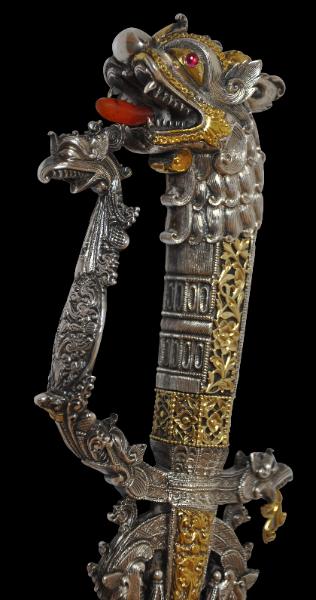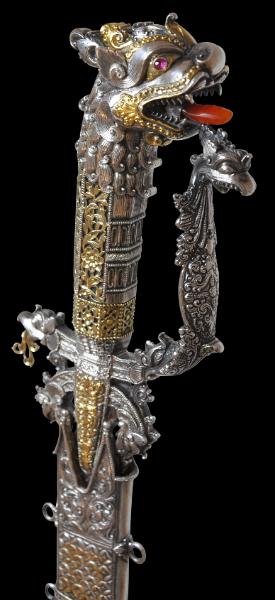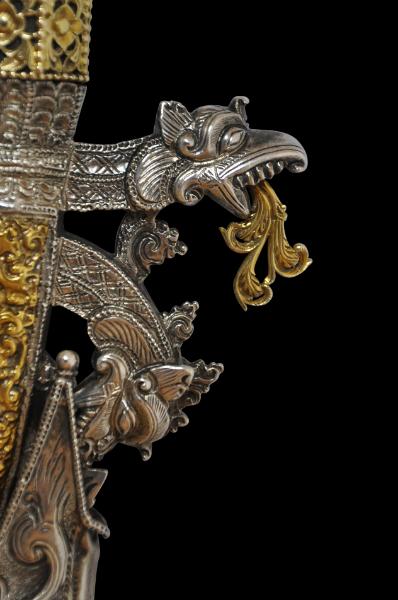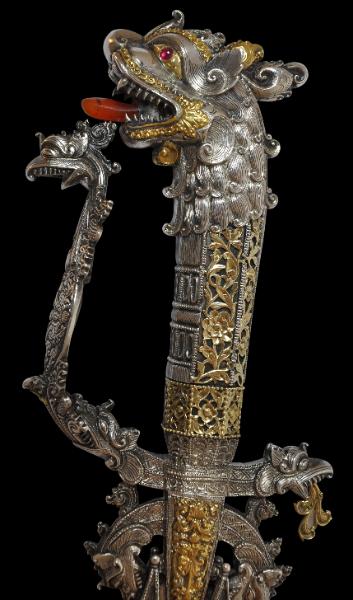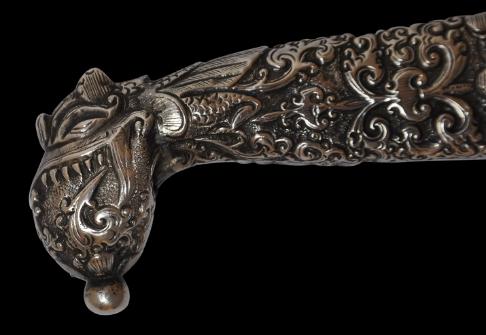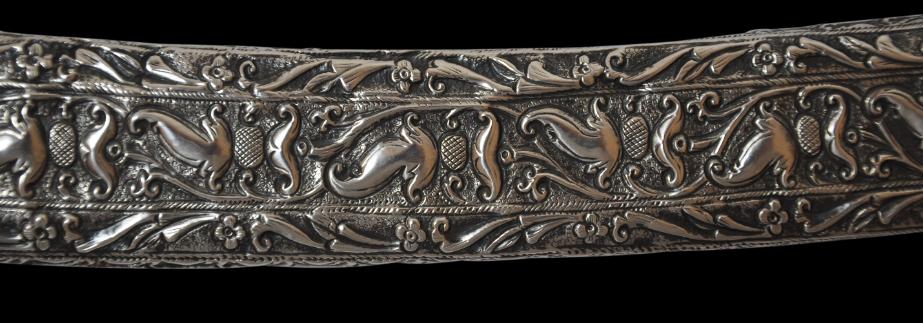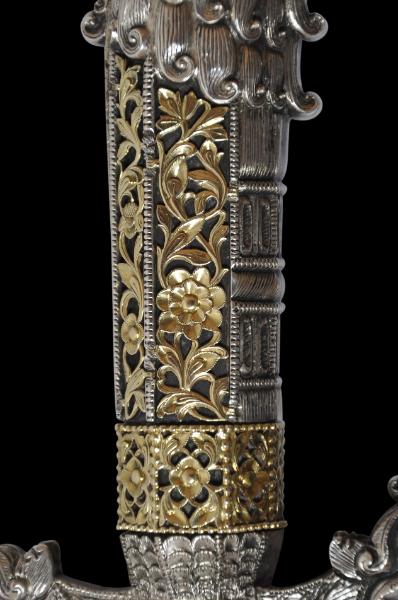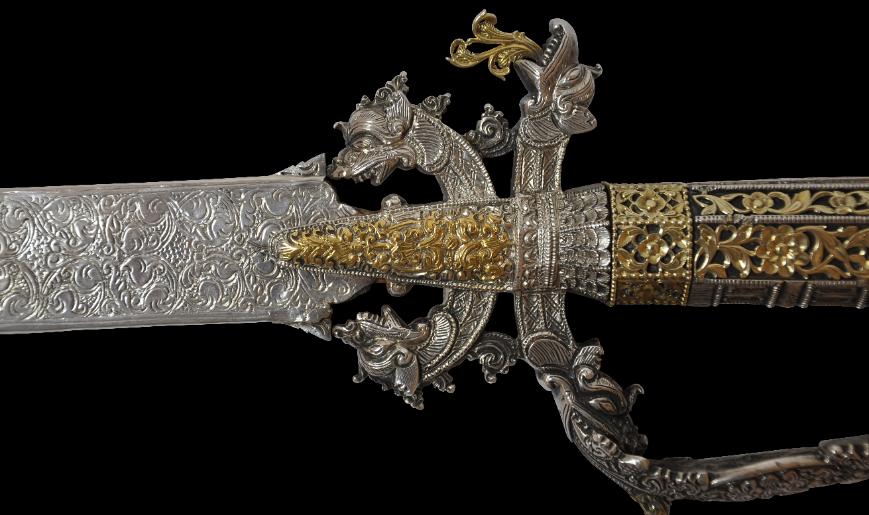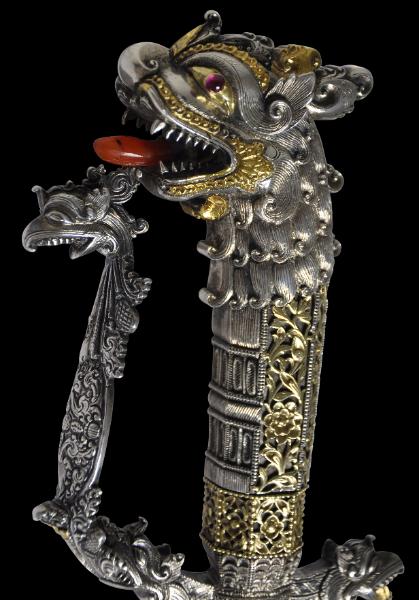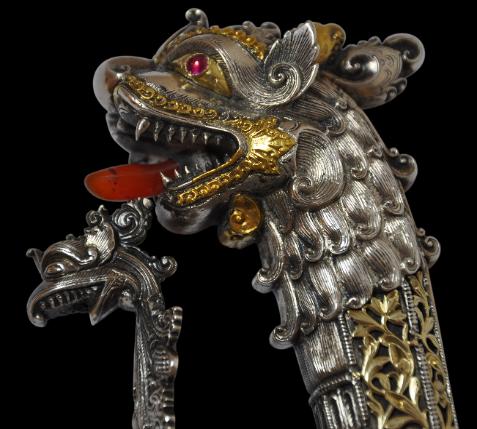
Ceylonese Kasthane Sword
Noble’s Silver Kasthane Sword with Solid Gold Mounts and inlaid with Pink Sapphires
Sri Lanka
18th century
length: 62cm, weight: 720g
This is the finest kasthane that we have seen. The chiselling work is magnificent, and unusually, rather than being gilded or gold-plated, it is inset with pure gold (probably around 18-20 carats). The eyes of the hilt are set with pink sapphires and most unusually, the tongue emitted from the lion that forms the hilt is of a single piece of carved agate rather than being made of silver.
The kasthane is unique to Sri Lanka. It is a dress sword that was popular in both the central Kandy Kingdom and the low, coastal areas. Kasthanes found their way to Europe and elsewhere in the seventeenth and later centuries as highly decorative curios. Sir Alexander Popham, an English seventeenth century military figure, was painted in his equestrian portrait wearing a kasthane. Kasthanes have relatively weak blades; as dress swords they were intended to be ornamental and reality served as over-sized pieces of jewellery for Ceylonese aristocrats.
This especially fine kasthane has a silver pommel chiselled as a typical simha (lion) head with a prominent crest made up of an entwined liya-pata motif covered in sheet gold. A narrow, pala-peti design is around the mouth and this too has been covered in sheet gold. The gaping mouth has an orange agate or carnelian tongue that projects right out of the moth and rows of especially sharp and naturalistically-rendered teeth. The snout on each side has a characteristic ‘S’ scroll. The eyes are large and distinct and comprise pink sapphires in gold mounts and with magnificently scrolled eyebrows. The ears are prominent and in leaf form.
The simha’s main comprises a series of semi-circular whirls on top and a spectacular array of whirls about the neck. The rest of the neck comprises floral and foliate liya pata panels four of which have been inset with pierced, solid gold plaques.
The narrow crossguard has two serapendiya head quillon finials. An ‘S’-shaped knuckle guard issues from the mouth of one and this guard terminates with a prominent serapendiya head. The other serapendiya head quillon finial looks away from the back of the simha. A solid gold flourish issues from its mouth.
The ricasso at the root of the blade is encased in silver sheet engraved with the sinha flower motif within a scrolling trellis design. The langet is chased with a foliage and covered with sheet gold.
The blade, of steel, is single edged and curved. It finished with a point.
The scabbard is curved and chased or repoussed with rococo-esque scrolling floral and foliage patterns against a finely tooled ground, as well as an upper square section decorated with a geometric flower pattern and plated with gold. The scabbard is held together by the locket and another plain silver band. Four silver carrying rings are attached to the top of the locket. The chape is in the form of a serapendiya head disgorging a floral sphere which itself terminates with a plain silver bead.
The kasthane here appears to be related to an example in the National Museum in Colombo (illustrated in De Silva & Wickramasinghe, 2006, p. 171) which is believed to be the kasthane of King Bhuvanaikabahu of Yapahuwa. Both the example here and the National Museum example have agate tongues emitted from the heads of the simha hilts.
The kasthane here is in very good condition. There are no apparent losses. The scabbard appears to have a small solder repair to one side but this is lost in the decorative profusion. The blade shows signs of past rusting. The silverwork and goldwork is of the highest quality and the inset, pierced gold plaques are especially fine.
References
Caravana, J. et al, Rites of Power: Oriental Weapons: Collection of Jorge Caravana, Caleidoscopio, 2010.
Coomaraswamy, A.K., Mediaeval Sinhalese Art, Pantheon Books, 1956 reprint of the 1908 edition.
De Silva, P.H.D.H & S. Wickramasinghe, Ancient Swords, Daggers & Knives in Sri Lankan Museums, Sri Lanka National Museums, 2006.
Weereratne, N., Visions of an Island: Rare works from Sri Lanka in the Christopher Ondaatje Collection, Harper Collins, 1999.
Provenance
UK art market
Inventory no.: 2129
SOLD

